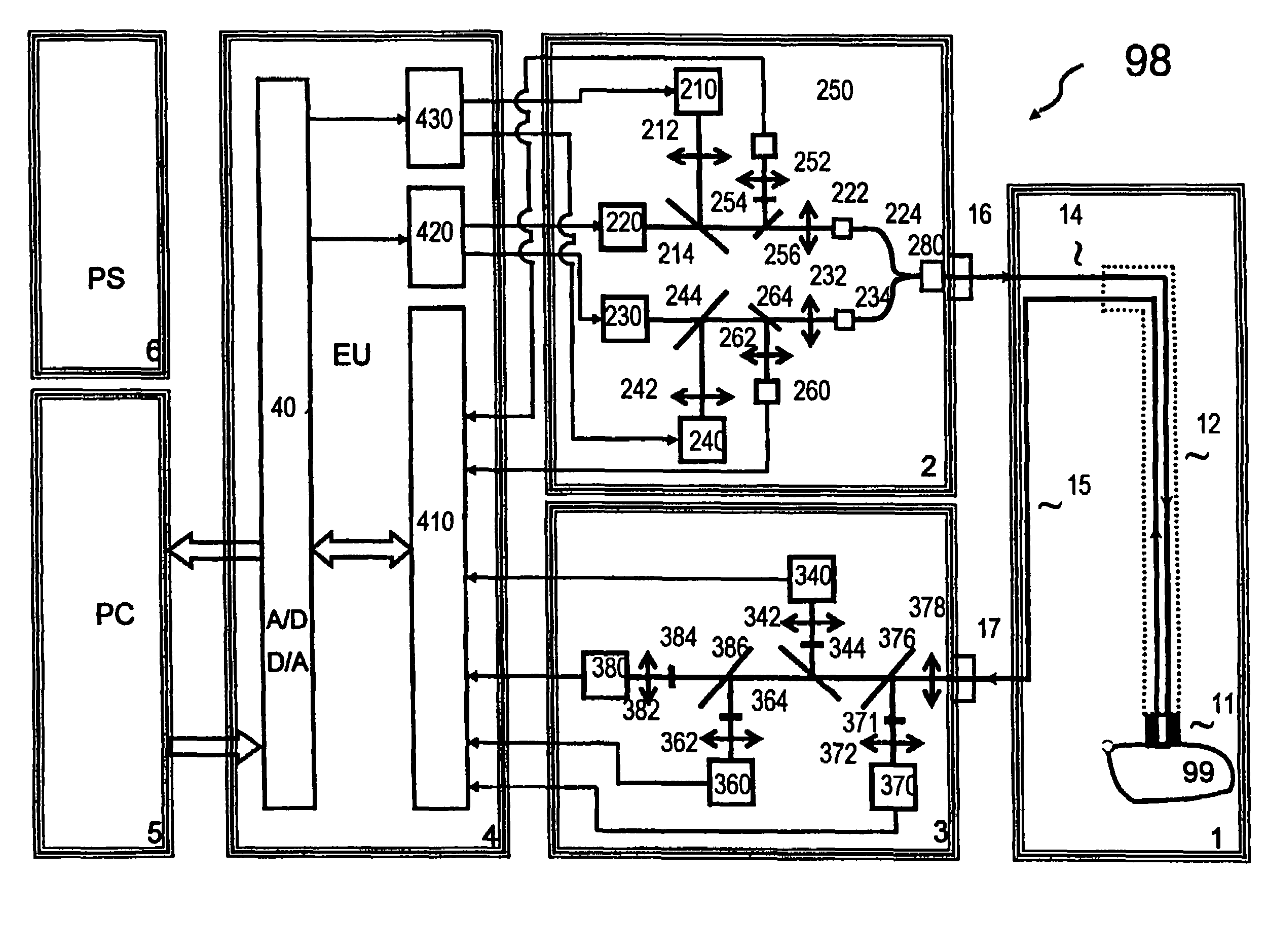Diagnosis of body metabolic emergency state
- Summary
- Abstract
- Description
- Claims
- Application Information
AI Technical Summary
Benefits of technology
Problems solved by technology
Method used
Image
Examples
first embodiment
[0222]Referring to FIG. 19, the probe, generally designated (101), comprises all the elements and features of the probe (1) as described herein, mutatis mutandis. In addition, the probe (101) is particularly adapted for optical measurement of low-radiance signals from the inner surface of elastic body vessels, during catheterization. This is achieved by bending the fibers, which are laid along the internal axis of the catheter, at an angle 90 degrees, or close thereto. In this manner, the distal end of the fibers, i.e., the end from which light is emitted or received, comes into direct contact with the tissue, which is typically concentric with the probe (101). This arrangement for the fiber distal ends eliminates the costly and complicated treatment which would otherwise be required to be performed to the fibers ends, to convert these into “side firing” or “side facing” fibers. Moreover, this arrangement is superior to such side facing fibers, in which the coupling efficiency betwe...
second embodiment
[0225]Referring to FIG. 20(a) and FIG. 20(b), the probe, generally designated (201), comprises all the elements and features of the probe (1) as described herein, mutatis mutandis. In addition, the probe (201) is particularly adapted for surface attachment to neonates' skin, using adhesive gels. Such gels (such as Ten20, by DO Weaver and Co. CO, USA, for example) are widely used with non-disposable neurodiagnostic electrodes. Thus, the head (21) is in the form of a cylindrical button, typically made from a suitable plastic, and comprises a fiber optic bundle (23). The distal end of the fiber bundle (23) is located at the center of the contact face (30) of the head (21), which also comprises two concentric open channels (25), (27). After slightly overfilling the outermost channel (25) with adhesive gel, the head (21) is pressed towards the skin and adhered thereto. The bundle (23) and plastic guide (28) which projects distally at the distal tip thereof form the contact surface (A2), ...
third embodiment
[0227]Referring to FIG. 21(a) and FIG. 21(b), the probe, generally designated (301), comprises all the elements and features of the probe (1) as described herein, mutatis mutandis. In addition, the probe (301) is particularly adapted for surface attachment to neonates' skin, using adhesive tape or the like. Thus, the head (31) is in the form of a mouse, and made of relatively soft (30 to 40 Shore A) RTV Silicone or silicone rubber, such that its contact surface (A3) may easily adapt to the skin contour of the patient. A fiberoptic bundle (34) is embedded into the head (31), forming an internal bend (35) of obtuse angle. Since the silicone is elastic with respect to the fibers, it can not force the required additional sharp angled bend upon the fibers. Thus, the head (31) comprises a pre-molded stiff kernel (32), made from medical grade epoxy for example, wherein to form and maintain the bend (35). The kernel (32) is then embedded into a silicone body, thereby positioning the fibers ...
PUM
 Login to View More
Login to View More Abstract
Description
Claims
Application Information
 Login to View More
Login to View More - R&D
- Intellectual Property
- Life Sciences
- Materials
- Tech Scout
- Unparalleled Data Quality
- Higher Quality Content
- 60% Fewer Hallucinations
Browse by: Latest US Patents, China's latest patents, Technical Efficacy Thesaurus, Application Domain, Technology Topic, Popular Technical Reports.
© 2025 PatSnap. All rights reserved.Legal|Privacy policy|Modern Slavery Act Transparency Statement|Sitemap|About US| Contact US: help@patsnap.com



